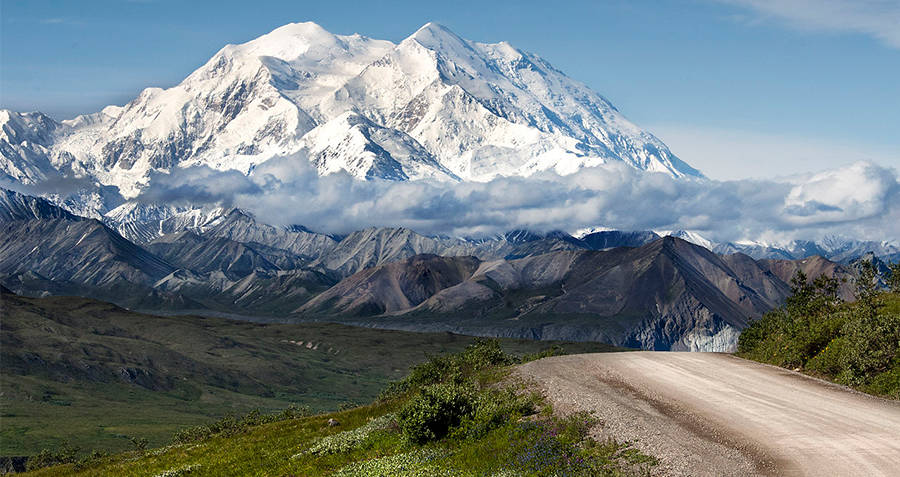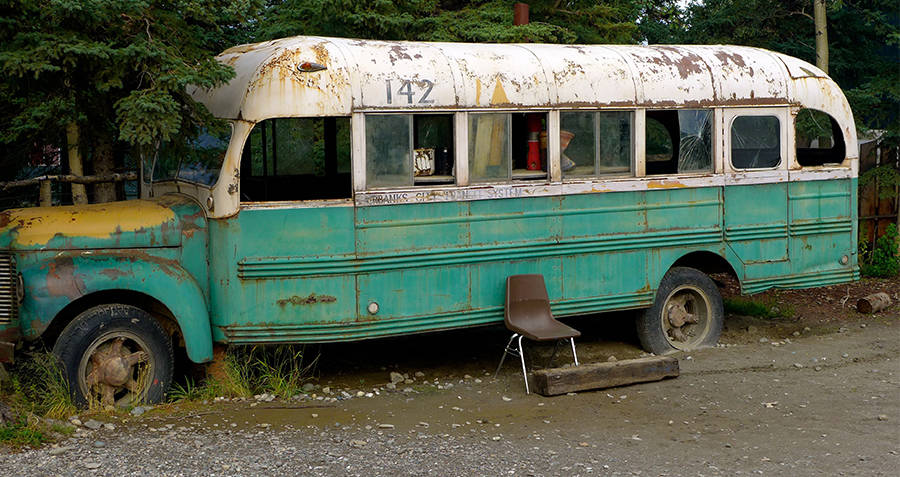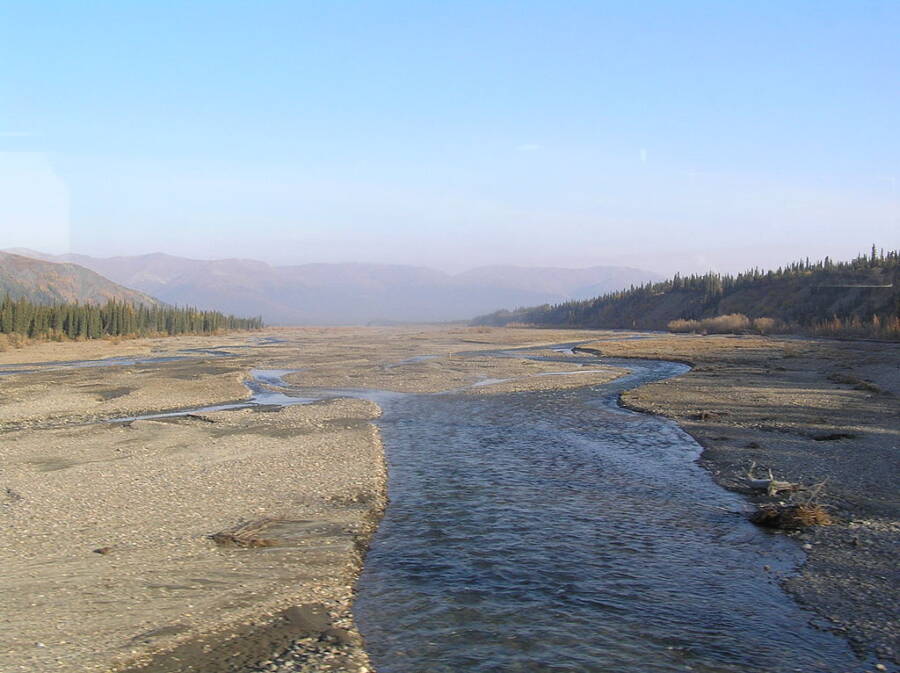Chris McCandless was an ambitious young man who insisted on trekking into the wilds of Alaska on his own. A few months later, he was found dead. To date, the circumstances surrounding his death remain unclear.
Into The Wild, the 2007 movie about the Alaskan wilderness adventure of college graduate Chris McCandless, seems like a work of fiction.
However, it’s based on a true story: on September 6, 1992, a pair of moose hunters came across an old, rusted bus just outside of Denali National Park. A notable landmark of the area, the bus had served as a stopping point for travelers, trappers, and hunters for many years.

Wikimedia CommonsA portrait taken by Chris McCandless of him and his bus.
What was unusual was the crumpled note taped to its door, handwritten on a piece of paper torn out of a novel:
“ATTENTION POSSIBLE VISITORS. S.O.S. I NEED YOUR HELP. I AM INJURED, NEAR DEATH, AND TOO WEAK TO HIKE OUT OF HERE. I AM ALL ALONE, THIS IS NO JOKE. IN THE NAME OF GOD, PLEASE REMAIN TO SAVE ME. I AM OUT COLLECTING BERRIES CLOSE BY AND SHALL RETURN THIS EVENING. THANK YOU.”
The note was signed by the name Chris McCandless, and dated “? August.”
Inside the bus was Chris McCandless himself, dead for the past 19 days. His death would spark a years-long investigation into his life, culminating in the 1996 Jon Krakauer book Into The Wild.
McCandless kept a diary detailing his adventures. Yet, many things remain a mystery, especially the events leading up to his death.
Chris McCandless Steps Into The Wild
It is known for a fact that in April 1992, McCandless hitchhiked from Carthage, South Dakota to Fairbanks, Alaska. Here, he hitchhiked again, being picked up by local electrician named Jim Gallien on his out way of Fairbanks.
The young man introduced himself only as “Alex,” denying any attempts to reveal his last name. He asked Gallien to take him to Denali National Park located to the southwest, where we said he wished to hike and “live off the land for a few months.”
Gallien later recalled having “deep doubts” about McCandless’ ability to survive in the wild, as the Alaskan wilderness was known to be particularly unforgiving.
McCandless didn’t have appropriate equipment, though he insisted that he would be fine. Gallien attempted to persuade the naive youngster to reconsider his adventure, even offering to drive McCandless to Anchorage and buy him proper equipment.
But the young adventurer remained stubborn. From what Gallien recalled, he was equipped only with a light backpack, a ten-pound bag of rice, a Remington semiautomatic rifle, and a pair of Wellington boots, which Gallien had given him. He had no compass and left his watch and the only map he had in Gallien’s truck.
Gallien dropped him off at the head of the Stampede Trail, west of the park, on April 28, 1992. McCandless handed Gallien his camera and asked him to snap a picture before heading out into the wilderness.

Wikimedia CommonsDenali National Park.
Into The Wild
Although Chris McCandless planned for an extended hike going all the way west to the Bering Sea, he stopped some 20 miles into his journey at a rusted old bus, presumably because it seemed like a great place to set up camp.
The blue and white paint was peeling from the sides, the tires were long deflated, and it was almost overgrown by plant life. However, McCandless was clearly happy to find shelter. He scribbled the following proclamation on a piece of plywood inside the bus:
Two years he walks the earth. No phone, no pool, no pets, no cigarettes. Ultimate freedom. An extremist. An aesthetic voyager whose home is the road. Escaped from Atlanta. Thou shalt not return, ’cause “the West is the best.” And now after two rambling years comes the final and greatest adventure. The climactic battle to kill the false being within and victoriously conclude the spiritual pilgrimage. Ten days and nights of freight trains and hitchhiking bring him to the Great White North. No longer to be poisoned by civilization he flees, and walks alone upon the land to become lost in the wild.

Wikimedia CommonsThe bus used for Into the Wild, an exact replica of McCandless’ actual bus.
Surviving In The Alaskan Back Country
For some 16 weeks, Chris McCandless would live in this bus. His adventure was fraught with difficulty, as his diary entries detail being weak, snowed in, and failing in his attempts to hunt for game. Yet, after a rough first week, McCandless gradually settled into his new lifestyle.
He survived off the rice he’d brought with him, as well as foraging local plant life and shooting small game like ptarmigan, squirrels, and geese. At one point he even managed to kill a caribou, though the carcass rotted before he could make much use of it.
However, the last month of entries seems to paint an entirely different picture.

Emile Hirsch starring as Chris McCandless in the 2007 movie Into The Wild.
Returning To Civilization
After two months, Chris McCandless had evidently had enough of living as a hermit and decided to return to society. He’d packed up his camp and began the trek back to civilization on July 3.
Unfortunately, the path he had previously taken over the frozen Teklanika River was now thawed. And instead of a small stream, McCandless now faced the surging waters of a 75-foot-wide river fueled by melting snow. There was no way for him to pass.
What he didn’t know was that there was a hand-operated tram a mile downriver that would allow him to make the crossing quite easily. Better yet, there was a cozy cabin stocked with food and supplies six miles south of the bus, marked on most maps of the area.
It was precisely the kind of information McCandless might have been aware of had he listened to Gallien and taken more care to prepare for his journey.

Wikimedia CommonsThe Teklanika river, which may have been frozen when McCandless first crossed it on his way to the bus, swells in size during the summer months due to melting snow.
Desperate Survival In The Alaska Wilderness
Unable to cross, McCandless, turned around and headed back to the bus. His diary entry from that day said “Rained in. River look impossible. Lonely, scared.”
Upon reaching the bus on July 8, McCandless’ journal entries become progressively shorter and bleaker. Although he continued to hunt and gather edible plants, he was growing weaker as he expended far more calories than he ate during his three months in the Alaskan bush.
The last entry in the journal, written on the 107th day of his stay in the bus, read only “Beautiful Blue Berries.” From then until day 113, his last spent alive, the entries were simply days marked with slashes.
On the 132nd day after Chris McCandless was last seen, his body was discovered by hunters. One of the men who had read the note entered the bus and found what he thought was a sleeping bag full of rotting food. Instead, it was Chris McCandless’ body.
Making Sense Of Chris McCandless’ Death
The cause of Chris McCandless’ death has been debated for decades. The first assumption was that he had simply starved. His rice supply had diminished, and the hungrier he got, the harder it had been for him to find the energy to get up and hunt.
However, Jon Krakauer, the first journalist to cover the story of Chris McCandless, came to another conclusion. Based on journal entries that detailed his food sources, he believes McCandless may have eaten poisonous Hedysarum alpinum seeds.
In a healthy person, the seeds may not have been dangerous as the toxin in them is usually rendered ineffective by stomach acid and gut bacteria. However, if he had eaten the seeds as a last resort, his digestive system may have been too weak to combat the poison.
Indeed, one of his last journal entries dictates a sickness caused by “pot[ato] seed.”
Another suggestion was that McCandless was killed by mold. This theory states that the poisonous seeds had been improperly stored in a damp environment. Other poisons and toxins have also been put forth as explanations, though no definitive conclusion has been reached.
An Enigmatic Young Man

Paxson Woelber/FlickrA hiker takes a photograph resembling Chris McCandless’ iconic self-portrait at the abandoned bus.
Another fascinating element of Chris McCandless’ story is the photographs he left behind. His camera contained dozens of photographs detailing his journey, including self-portraits. These photos only deepen the mystery.
In them, the physical deterioration of Chris McCandless is obvious. His body was wasting away, yet he appeared to be smiling and continued to live in solitude, only asking for help at the last possible moment.
In the end, despite the numerous investigations, we’re still not entirely sure how McCandless died and what he thought about during his final moments. Did he miss his family? Did he realize he put himself in this situation?
McCandless’ story continues to inspire interest even decades after his death, highlighted by the 2007 film Into The Wild.
After all, many young people can share the sentiment of getting away from civilization and surviving on your own. To them, Chris McCandless is an epic, if tragic, representation of that ideal.
After learning about Chris McCandless and the real story behind Into the Wild, check out the wild monkeys that helped a tourist while he was lost in the Amazon. Then, read about how animals camouflage themselves in the wild.





